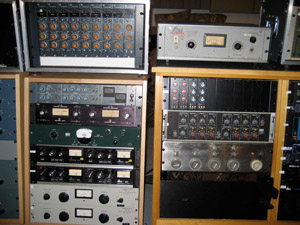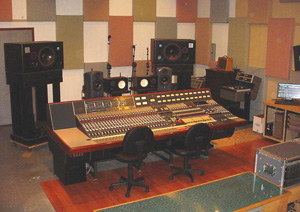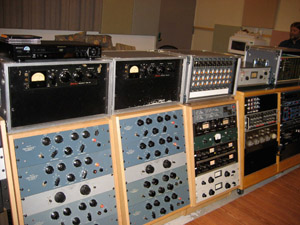The State of Fluxivity
WILLIAMSBURG, BROOKLYN: We first caught wind of Fluxivity, a ‘best-kept secret’ mixing studio in Williamsburg, from a NYC-based engineer/producer who called its Neve 8048 custom console, the best-sounding Neve he’s ever heard. “Wait a second,” we said, “what and where is this place?!” You may be wondering the same!
Fluxivity owner Nathaniel Priest has been in the audio biz here in NYC for over 20 years, working the studio circuit as a staff technician (Power Station, Sigma Sound and Right Track), independent technician and custom tube equipment manufacturer. In that time, he’s accumulated loads of equipment, expertise and acoustical acumen.
“In the back of my mind,” shares Priest, “I always felt there’d be an opportunity for me to set up all this equipment in a proper studio, and either use it myself or book out to artists and engineers.”
Priest’s tech/repair/manufacturing business — Music Valve Electronics — had always been based in Manhattan, kept on the move by gentrifying neighborhoods and skyrocketing rents. Landing in larger space in Williamsburg in ‘02, Priest set up shop with Fluxivity, the studio, in mind. He and a friend, a custom motorcycle manufacturer, moved into what was an unlicensed auto repair shop on S. 2nd Street, right at the Williamsburg Bridge.
“The place was filled with auto parts and cars, and we had to get rid of all of it and transform the space,” says Priest. “But we were happy to do that; cleaning up, painting, refurbishing the place yourself makes for a better relationship with the landlord, and in economic terms, it’s a better deal.”
They divided the space, Priest converting the back half of the one-story building into a tech workshop and a large control room he treated acoustically to continue his equipment repairs, designs and manufacturing. A few years later, his building partner outgrew his half of the space and moved. Priest took over the whole building, and continued to shape and refine Fluxivity alongside Music Valve — two businesses under the one roof.
You’ve heard of the studio with the in-house tech, well Fluxivity is the tech with the in-house studio.
THE SPACE TO LISTEN, CRITICALLY
Fluxivity’s uniquely open and spacious control room features the Neve 8048 (with Flying Faders) at center facing big ATC mains on pillars and backed up by a long producers desk housing prized outboard gear from Fairchild, Pultec, Neve, etc. Further behind the producer’s desk is a couch and lounge area. The large room provides ample space in which to setup gobos for overdubs, and — according to Priest — to listen critically.
“I’ve worked in a lot of studios in the NYC area over the last 20 years and there’s never been any one studio topology that totally made sense to me,” says Priest. “I never subscribed to the typical acoustical layout of having that one sweet spot in the middle of the room so that the one person sitting at the console can hear what’s going on. Making music is a collaborative experience, and usually a group effort. At Fluxivity, I wanted to create an optimal listening environment over a much wider area.”
Building and positioning all the acoustic treatments himself, Priest created this unconventionally large-room listening environment, fed by his ATC SCM 150 ASL main monitors, the same model used in The Living Room — one of NYC’s best acoustic venues.
“I took at least a year to set up the speakers and complete the acoustic treatment in here because I wanted to listen to the room over that long period of time,” Priest explains. “I found the best space for the speakers and then I treated the room acoustics in stages over the course of months, repositioning the speakers along the way. Finally, I found the best position for the speakers and then built the studio around that.”
These ATCs are by no means the typical studio speakers, but rather the particular kind of speaker Priest needed to create an environment in which everyone involved in a session can have a high-quality listening experience, anywhere in the room. “I think it’s a monitoring environment that’s much closer to the way the majority of people experience music,” says Priest. “Plus, in a session, the room should really work for the group. There’s a producer, an engineer, an artist, perhaps a band, managers, etc. The room should be a collaborative environment for creating high-quality audio. And the ATCs’ accuracy and neutrality are exceptional.”
FOSTERING A NEW ERA OF MUSICIANSHIP
Off the street, you enter Fluxivity through a raw, warehouse-style space lined with aisles and racks of equipment and parts and tools. There’s also a structure — a room within this large room — Priest has recently erected to serve as a second production/mixing studio. “I’ll put a Neve 53 series console and Pro Tools HD rig in there,” says Priest of his plans.
Space is not an issue here; Fluxivity will be able to expand as demand dictates, but always to foster artists and the new music economy. “The music business really went through a period of irrational exuberance and seemed to lose sight of important things,” Priest opines.
“It may not be a viable business model to have an enormous recording console and every last piece of equipment, but maybe having a 96-channel console was never the most direct way of making the absolute best music. I love a lot of jazz records from the 50s — which were made using way fewer and simpler tools, used in a manner to convey emotion. There’s a sound quality and pure musicality to them that’s still relevant today, and it speaks to the artistry of everyone involved. So, we went through this period of irrational exuberance in the music industry, and now we’re going to hopefully see another era of musicianship blossoming, less obstructed by business pressures.”
Back to basics — Fluxivity offers the space and classic signal paths to great-quality records. “I think I understand what a lot of artists need at the present moment: they want to complete their project and be able to have a good sense of the final quality of the finished product. That’s where Fluxivity comes in. I provide a good listening environment where people have access to the commonly used tools of the trade, and can feel confident they’re going to get quality results. I want to help people do that.”
TUBES, COMPRESSION, QUALITY & QUANTITY
In this day and age, it’s a serious understatement to refer to Fluxivity’s equipment as the “commonly used tools of the trade,” but Priest is a modest guy. Between the racks in the producers desk and the surplus of vintage gear he’s acquiring/repairing and moving via Music Valve, Priest has equipment you may have never seen before, let alone used, and multiples of many things.

Some of Fluxivity’s outboard, including the nine Neve 2264s (top left) and (second from top, right) the Avedis E27s in rack next to the API 550As, on top of the Klein and Hummel UE 400 Stereo parametric and Ampex MX-10 tube mic pre.
He points out the new Avedis E27 EQs as a highlight. “This is a wonderful tool, very high quality,” he says of the E27. “It has some really high frequencies on it [up to 28kHz] which will bring out some presence in recordings.”
Another technical highlight, Priest points out his nine Neve 2264s. “This is the same compressor that’s in the 8068 and 8078 consoles and it gives people tremendous flexibility to have 9 of these compressors which can be linked up or operate independently,” he notes.
Meanwhile, under Music Valve, Priest still buys, repairs and sells equipment and (mostly Neve) consoles, works as a studio technician and designs and builds custom equipment around tube preamplifiers — direct boxes and mic pre’s. Up until last year, Music Valve had a Tube Direct Box product in manufacturing since the mid 90s.
“My design approach was always to build equipment to reach a certain level of performance, and worry about the economic viability later,” says Priest. “When I started designing and building the direct box, that was never an issue. I used high-quality parts and everything was made in the USA or the UK. But it stopped being economically viable, with the wide variety of gear out there today, being manufactured in China.”
Not one to toot his own horn, Priest mentions some of the artists he’s built custom gear for but asked that they remain anonymous in this article. They’re some of the biggest names in the business. He’s also reluctant to reveal where this “best-sounding” Neve 8048 came from, but finally mentions that it was custom made for George Martin and lived in the big studio at Air from 1975-81. “But you should get the same results from any Neve console that’s been well taken care of,” he insists. Still… that’s pretty cool.
Fluxivity’s open for business. Drop Nat Priest a line for rates and any further details: studio@fluxivity.com.
Please note: When you buy products through links on this page, we may earn an affiliate commission.








